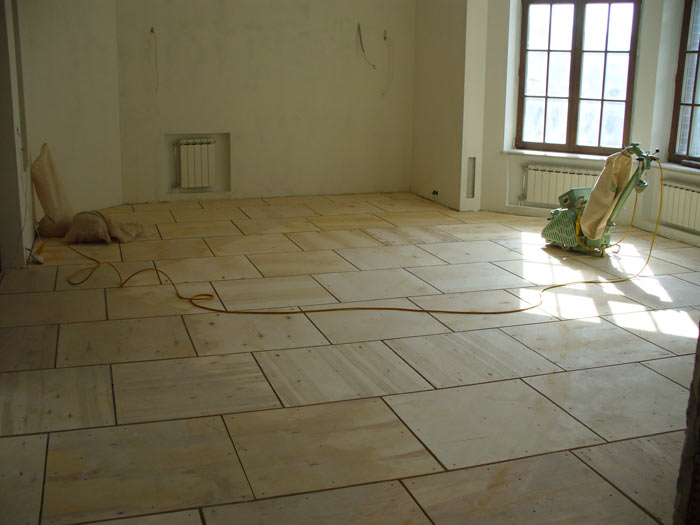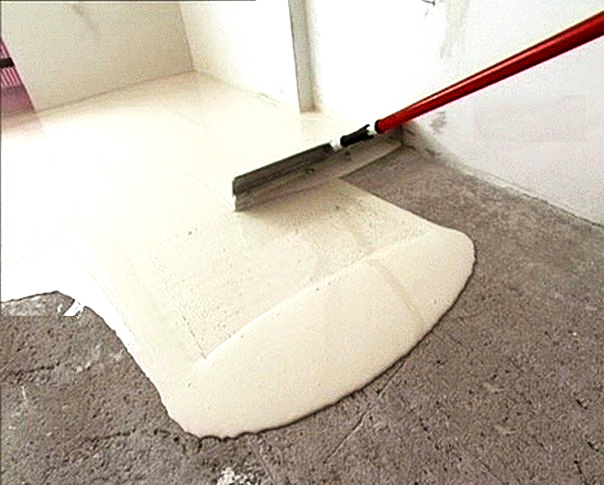Do-it-yourself adjustable floors: plywood raised floor + base on adjustable logs
Innovative ways to level the surface are designed to optimize the pace of finishing and reduce labor costs. A rather young innovation - adjustable floors provide finishers and homeowners with a significant number of technological and consumer benefits. With their help, quickly, simply, ideally the preparation of the rough surface is carried out, which does not require professional skills from the performer.
Universal designs of adjustable draft foundations are used to equip premises of any purpose, area, configuration. For old buildings with not very reliable ceilings, for light suburban cottages made of wood or foam concrete, the opportunity provided by this technology to not load the floor with a multi-ton concrete screed is an impeccable option. For new buildings with low ceilings, this is an opportunity not to reduce the height of the rooms, which are not very pleasing to the spaciousness.
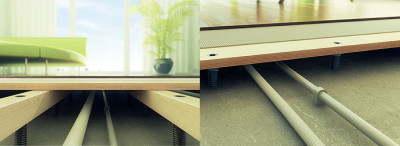
Content
Advantages of adjustable draft substrates
Structurally progressive leveling floor systems are a solid dense flooring with mechanical devices with which the floor is adjusted in a horizontal plane. The main features of this technology:
- Floor systems with adjusting devices are mounted in a couple of days.
- Durable adjustable floors can be installed with your own hands by a person who is first engaged in flooring.
- Between the rough surface and the floor there remains a useful technological gap that improves the insulation quality. In this space, you can lay communications, complement the insulation by laying synthetic or mineral insulation.
- The floor plane can be raised to a level of 20 cm, reduce the power of the leveling layer to 3 cm, you can arrange a multi-level floor with one or more podiums.
- The elements of the leveling system are rigidly fixed to the concrete or wood base.
- It is possible to abandon the substrate, traditionally used when laying parquet and a number of other types of floor coverings. This is another economic plus, reducing the cost of flooring by almost half.
- After the clean, dry installation of the adjustable substrates has been completed, there is no need to postpone the finishing work, for example, due to the expectation that the screed is completely cured.
According to the assurances of experienced foreign users, adjustable floors will serve faithfully for half a century. The presence of a ventilated cavity also eliminates the likelihood of premature “aging” of the ceilings, and the floor will not suffer during emergency floods.
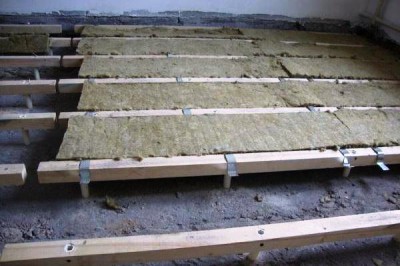
Floors arranged using this technology will not creak annoyingly, will not warp, as is the case with outdated floor adjustments for logs, which can be done using loose wood chips or sand.
Progressive systems, supplied from abroad and produced by domestic enterprises, are distinguished by another important advantage - affordable price, almost a third of money invested in leveling money can be saved by abandoning a cement-sand screed.

Two kinds of adjustable designs
According to the design features and the specifics of the application, the adjustable floors are divided into two varieties:
1. Systems consisting of dense durable chipboard plates, adjustable in the horizontal plane with the help of special devices made of heavy-duty plastic. They are preferred to be installed in new buildings, since the leveling power of the plates raises the floor surface to a minimum height of 3-5 cm. Despite the small size of the technological space under the raised floors, it is still possible to lay a cable and thin insulating material.
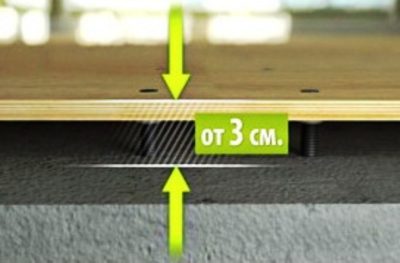
2. Practical floors on adjustable logs, the laying technology of which is similar to the standard device of a multilayer pie with bars-logs. The difference lies in the strong fixation of the elements to a concrete or wooden base and in the accurate adjustment of the horizontal lines. This type of floor is used for arranging apartments in old buildings and luxury housing with the planned “underground” installation of communication pipelines and cables.
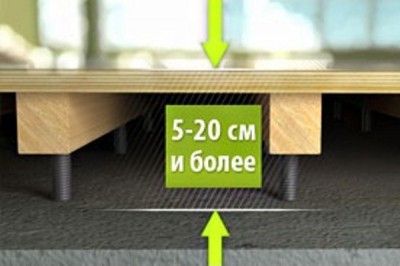
One of the valuable priorities of these leveling structures is the reliable fixation of the entire system to a wooden or concrete base.
More precisely, threaded anchor devices are firmly attached to the base material, the rotation of which around its own axis allows you to increase and decrease the height of the level of the subfloor. Easy-to-install adjustable floor supports mount:
- to wooden beams of floors with screws;
- to hollow concrete slabs inside and to the surface with concrete screed with polypropylene hedgehog dowels for brick and concrete;
- to a monolithic base concrete floor with dowel-nails.
Anchor devices perform several functions at the same time: they take part of the load, provide adjustment and a strong connection of the structure to the ceiling.
Installation of floors with leveling plywood
A distinctive feature of this technological option is that the bolts are inserted directly into the holes drilled in the plywood flooring, in the DSP board or in the gypsum fiber sheet. Here is the order of work:
- on the back side, bushings are inserted into the drilled holes, on the inner surface of which a thread is laid, the step between the holes depends on the expected load;
- then screw-up bolts made of durable polymer are screwed into the holes with bushings;
- the assembled element is installed on the floor;
- bolts are fastened to the base base;
- by rotating the strut bolts around the axis, the horizontal plane is leveled;
- the remains of the bolts rising above the surface are cut off;
- then overlap the next layer of flooring.
The butt seams between the plates of the first layer of the flooring should not coincide with the location of the seams of the second layer.

On top of the leveled surface, any type of finish flooring is laid.
Installation of floors with adjustable lags
Both types of leveling systems are produced by the company dnt: adjustable floors, which it supplies to the market, are a success. In the list of products of the manufacturer, you can choose a ready-made system for any design floor height, regardless of the type of base and material selected for finishing.
Leveling systems with logs produced by the company are raised and lowered by rotation of the rack bolts.
- heavy-duty polymer anchor bolts are screwed into the threaded holes in the lags;
- lags with a step depending on the design characteristics of the floor are installed on the floors;
- a hole is drilled through each anchor in a wooden beam or in a concrete massif, a dowel-nail or a self-tapping screw is driven into the hole obtained;
- lags align, checking their position with a level gauge or laser device;
- the excess plastic bolts are cut off, the subfloor flooring is laid on top.
The complete set of structures prepared for installation is selected depending on the strength characteristics of the flooring planned for laying, on the distance between the logs and the cross-section of the beam, on the flooring power.
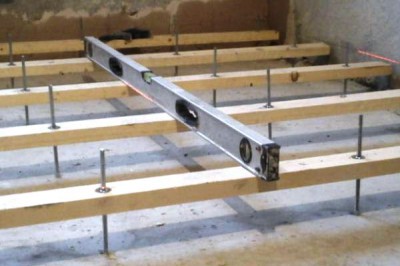
Self-made regulating anchor
In principle, knowing the design features, both leveling systems can be made with one's own hand. Indeed, in the hardware store you can buy all the components: flooring - thick plywood, GVL, chipboard; logs - an ordinary wooden bar. It will be problematic to buy only polymer bolts with large threads. However, you can make your own anchor for an adjustable floor.
To make an analog of a regulating device, the master will need:
- driven anchor;
- hairpin;
- two nuts and washers;
- metal plate.
The stud will serve as a support bolt that attaches to the base surface through the driven anchor. The support for the beam will be a metal plate attached to the stud with a bolt and a pair of nuts. This nut will be adjusted. Another nut with a bolt is needed to fix the beam on top. So that the upper nut does not subsequently interfere with the laying of the finishing material, a groove is made from above in the lag. After alignment, the excess hairpin is cut off.
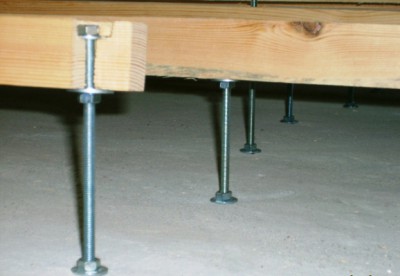
A do-it-yourself leveling system made by yourself or bought at a hardware store will significantly reduce the budget for repairs or finishing in a new building. Fast, clean styling makes it possible to eliminate wet, dirty and fairly expensive processes.

